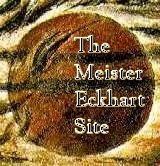|
|
||
 |
Meister Eckhart Home / Works by Meister Eckhart - Quotes / Inspired by Eckhart / Studies / The Papal Condemnation / Mail & Announcements / Links / Books |
ERNST TROELTSCH
From:
Ernst Troeltsch, The social teaching of the Christian
Churches, v. II,
tr. Olive Wyon, 1931, pp. 730 - 741. Here published without footnotes.
Page 4
Here, in this primitive Christian pneumatic enthusiasm, and in the Pauline Christ-mysticism, lie the inexhaustible sources of Christian mysticism. In the Fourth Gospel this mysticism has already become calm and controlled, and adjusted to the historical and objective side of religion. Here, in particular, however, it has also produced or discovered its really characteristic formulas - flesh and spirit, darkness and light, allegory and "the letter".
Other early Christian writings contain similar elements. Through the New Testament, spiritual enthusiasm and Pauline mysticism became a permanent source of power, stimulating the corresponding sense of need and vivifying its formulas. This mysticism has expressed itself in a very vital way at all periods of Church history, and particularly at all periods of criticism of tradition, of religious decline, and of new religious developments.
The germ of the idea of the Church as an institution was already latent within Primitive Christianity, for it was given naturally with the conception of grace, of a finished salvation, and of the salvation of the world. Primitive Christianity also contains the germ of the sect-idea, which reveres the Sermon on the Mount as the moral law of its Master and continues His expectation of the coming of the Kingdom of God upon earth, and gathers the pure and holy into the fellowship of the Church which waits for Christ's return. Primitive Christianity also contains the germs of a mysticism for which this fleeting world is but a symbol, all that belongs to the sense-life and to the earthly sphere a mere limitation; for which every form of worship is only a means of substantial union, and all faith simply a direct translation from the visible to the invisible, into the very life of God and Christ.